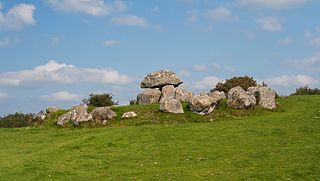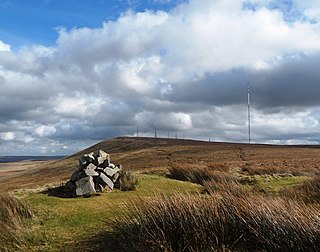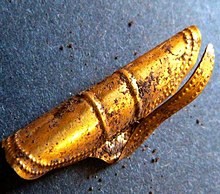
A chambered cairn is a burial monument, usually constructed during the Neolithic, consisting of a sizeable chamber around and over which a cairn of stones was constructed. Some chambered cairns are also passage-graves. They are found throughout Britain and Ireland, with the largest number in Scotland.

The Amesbury Archer is an early Bronze Age man whose grave was discovered during excavations at the site of a new housing development in Amesbury near Stonehenge. The grave was uncovered in May 2002. The man was middle aged when he died, estimated between 35 and 45, and is believed to date from about 2300 BC. He is nicknamed "the Archer" because of the many arrowheads buried with him. The grave contained more artefacts than any other early British Bronze Age burial, including the earliest known gold objects ever found in England. It was the first evidence of a very high status and wealth expressed in a burial from that time. Previously, Bronze Age society had been assumed not to have been particularly hierarchical.

The Bell Beaker culture, also known as the Bell Beaker complex or Bell Beaker phenomenon, is an archaeological culture named after the inverted-bell beaker drinking vessel used at the very beginning of the European Bronze Age, arising from around 2800 BC. Bell Beaker culture lasted in Britain from c. 2450 BC, with the appearance of single burial graves, until as late as 1800 BC, but in continental Europe only until 2300 BC, when it was succeeded by the Unetice culture. The culture was widely dispersed throughout Western Europe, being present in many regions of Iberia and stretching eastward to the Danubian plains, and northward to the islands of Great Britain and Ireland, and was also present in the islands of Sardinia and Sicily and some coastal areas in north-western Africa. The Bell Beaker phenomenon shows substantial regional variation, and a study from 2018 found that it was associated with genetically diverse populations.

The court cairn or court tomb is a megalithic type of chambered cairn or gallery grave. During the period, 3900–3500 BC, more than 390 court cairns were built in Ireland and over 100 in southwest Scotland. The Neolithic monuments are identified by an uncovered courtyard connected to one or more roofed and partitioned burial chambers. Many monuments were built in multiple phases in both Ireland and Scotland and later re-used in the Early Bronze Age.

Archaeology and geology continue to reveal the secrets of prehistoric Scotland, uncovering a complex past before the Romans brought Scotland into the scope of recorded history. Successive human cultures tended to be spread across Europe or further afield, but focusing on this particular geographical area sheds light on the origin of the widespread remains and monuments in Scotland, and on the background to the history of Scotland.

Beaghmore is a complex of early Bronze Age megalithic features, stone circles and cairns, 8.5 miles north west of Cookstown, County Tyrone in Northern Ireland, on the south-east edge of the Sperrin Mountains.

Carrowmore is a large group of megalithic monuments on the Coolera Peninsula to the west of Sligo, Ireland. They were built in the 4th millennium BC, during the Neolithic. There are thirty surviving tombs, making Carrowmore one of the largest clusters of megalithic tombs in Ireland, and one of the 'big four' along with Carrowkeel, Loughcrew and Brú na Bóinne. Carrowmore is the heart of an ancient ritual landscape which is dominated by the mountain of Knocknarea to the west. It is a protected National Monument.
Below are notable events in archaeology that occurred in 1935.

Prehistoric Wales in terms of human settlements covers the period from about 230,000 years ago, the date attributed to the earliest human remains found in what is now Wales, to the year AD 48 when the Roman army began a military campaign against one of the Welsh tribes. Traditionally, historians have believed that successive waves of immigrants brought different cultures into the area, largely replacing the previous inhabitants, with the last wave of immigrants being the Celts. However, studies of population genetics now suggest that this may not be true, and that immigration was on a smaller scale.

Doll Tor is a stone circle located just to the west of Stanton Moor, near the village of Birchover, Derbyshire in the English East Midlands. Doll Tor is part of a tradition of stone circle construction that spread throughout much of Britain, Ireland, and Brittany during the Late Neolithic and Early Bronze Ages, over a period between 3300 and 900 BCE. The purpose of such monuments is unknown, although archaeologists speculate that the stones represented supernatural entities for the circles' builders.

The dolmens of Jersey are neolithic sites, including dolmens, in Jersey. They range over a wide period, from around 4800 BC to 2250 BC, these dates covering the periods roughly designated as Neolithic, or “new stone age”, to Chalcolithic, or “copper age”.

The Banc Tynddol sun-disc is a small, decorated, gold ornament discovered at Cwmystwyth, Ceredigion, Wales. It most likely was part of a funerary garment and is dated to 2450-2150 BCE, which makes it the earliest gold artifact found in Wales. It was discovered on 16 October 2002 by a team of archaeologists who were investigating the site of Roman and medieval lead smelting hearths below the Bronze Age copper mine on Copa Hill.

Parc Cwm long cairn, also known as Parc le Breos burial chamber, is a partly restored Neolithic chambered tomb, identified in 1937 as a Severn-Cotswold type of chambered long barrow. The cromlech, a megalithic burial chamber, was built around 5850 years before present (BP), during the early Neolithic. It is about seven 1⁄2 miles (12 km) west south–west of Swansea, Wales, in what is now known as Coed y Parc Cwm at Parc le Breos, on the Gower Peninsula.

Whitehawk Camp is the remains of a causewayed enclosure on Whitehawk Hill near Brighton, East Sussex, England. Causewayed enclosures are a form of early Neolithic earthwork that were built in England from shortly before 3700 BC until at least 3500 BC, characterized by the full or partial enclosure of an area with ditches that are interrupted by gaps, or causeways. Their purpose is not known; they may have been settlements, or meeting places, or ritual sites. The Whitehawk site consists of four roughly concentric circular ditches, with banks of earth along the interior of the ditches evident in some places. There may have been a timber palisade on top of the banks. Outside the outermost circuit there are at least two more ditches, one of which is thought from radiocarbon evidence to date to the Bronze Age, about two thousand years after the earliest dated activity at the site.
The Pettigarths Field Cairns is a Neolithic site in the parish of Nesting, northeastern Whalsay, in the Shetland islands of Scotland. It is located approximately 140 metres (460 ft) to the northwest of Benie Hoose. The site contains upright stones as well as masonry. The south cairn is roughly 6 metres (20 ft) square, with an eastern entrance passage and circular chamber about 2 metres across. 4 metres (13 ft) to the north is a round cairn, 4.5 metres (15 ft) in diameter, with a rectangular cist. The two cairns are located on a rise, about 140 metres (460 ft) northwest of Benie Hoose.

The Grey Cairns of Camster are two large Neolithic chambered cairns located about 8+1⁄2 miles south of Watten and 5 miles (8 km) north of Lybster in Caithness, in the Highland region of Scotland. They are among the oldest structures in Scotland, dating to about 5,000 years ago. The cairns demonstrate the complexity of Neolithic architecture, with central burial chambers accessed through narrow passages from the outside. They were excavated and restored by Historic Environment Scotland in the late 20th century and are open to the public.

Noon Hill is a hill on the border of the boroughs of Chorley, Blackburn with Darwen and Bolton, in North West England. It is located on Rivington Moor, Chorley and is 380 metres (1,247 ft) high. Part of the West Pennine Moors, it is a popular walking area, and is of significant historical interest. The summit of Noon Hill is home to a Bronze Age burial mound which is listed under the Ancient Monuments and Archaeological Areas Act 1979 as it appears to the Secretary of State to be of national importance.

Cairnholy is the site of two Neolithic chambered tombs of the Clyde type. It is located 4 kilometres east of the village of Carsluith in Dumfries and Galloway, Scotland. The tombs are scheduled monuments in the care of Historic Scotland.

Herbert James Maryon was an English sculptor, conservator, goldsmith, archaeologist and authority on ancient metalwork. Maryon practiced and taught sculpture until retiring in 1939, then worked as a conservator with the British Museum from 1944 to 1961. He is best known for his work on the Sutton Hoo ship-burial, which led to his appointment as an Officer of the Order of the British Empire.

The Cornish Bronze Age is an era of the prehistory of Cornwall that spanned the period from c. 2400 BCE to c. 800 BCE. It was preceded by the Cornish Neolithic, and followed by the Cornish Iron Age. It is characterized by the introduction and widespread use of copper and copper-alloy (bronze) weapons and tools.


















